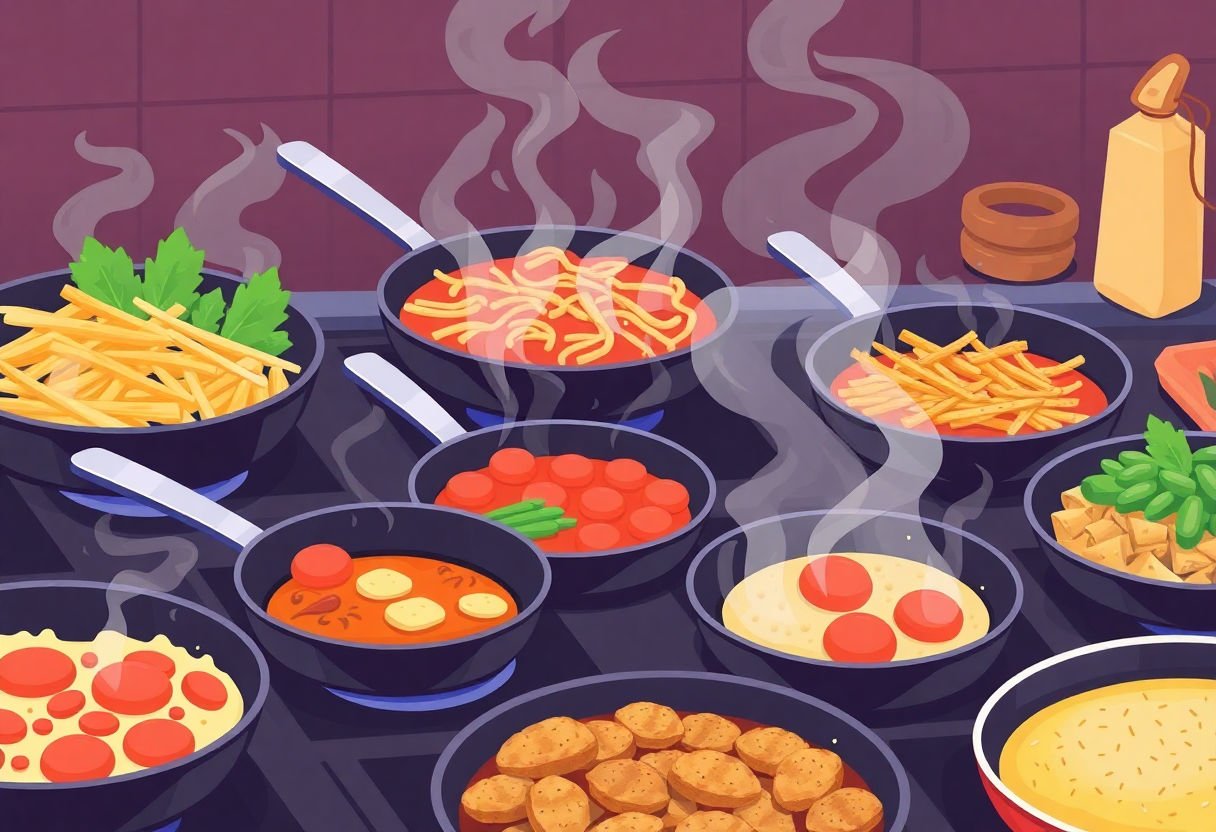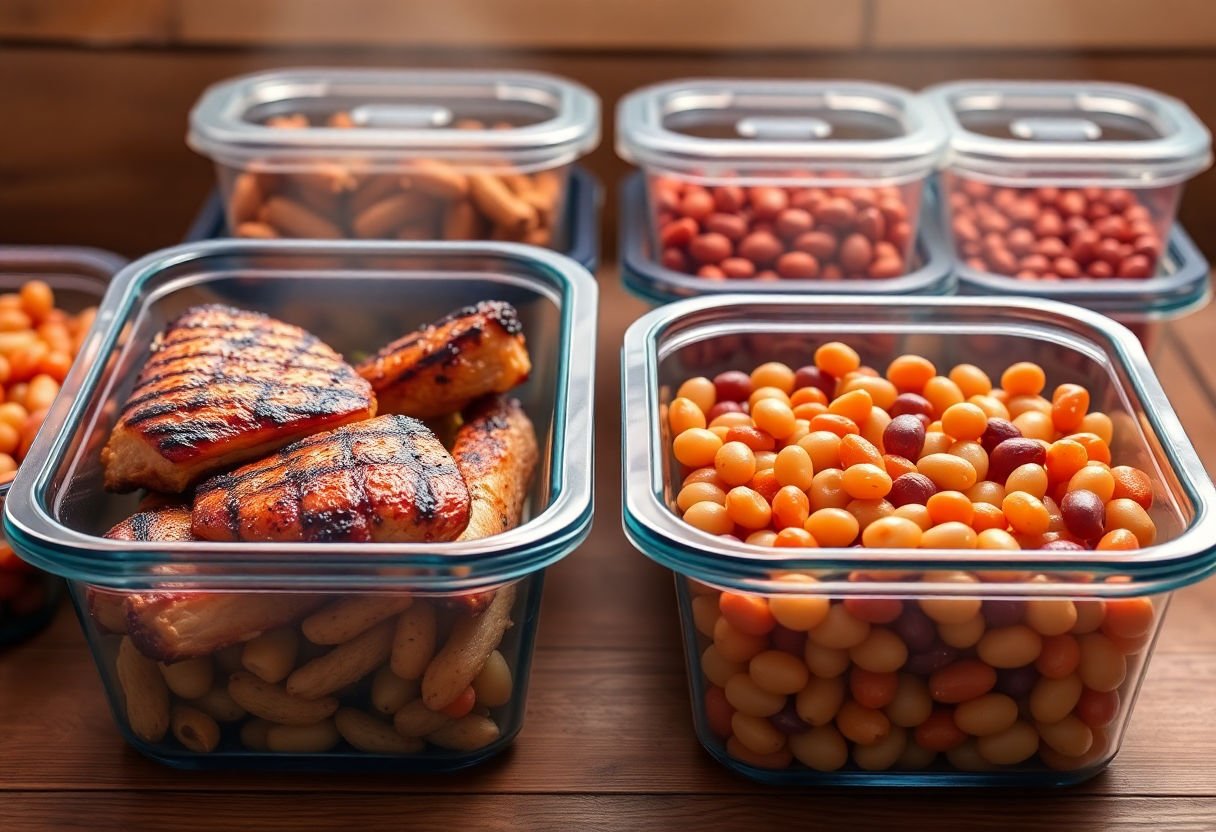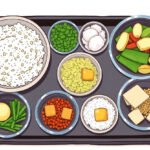Get ready to transform your weekly cooking routine with practical food prep ideas that make life a whole lot easier! Whether you’re facing hectic weekdays or trying to maintain a healthier lifestyle, these tips will help you save time and reduce stress. From batch cooking basics to mastering the art of organizing delicious, pre-made meals, you’ll discover methods that fit effortlessly into your schedule. Imagine having breakfast ready before you wake up or enjoying snacks that are as nutritious as they are tasty. Dive in to uncover how these strategies can simplify your life and enhance your dining experience!
Key Takeaways
- Efficient food prep can drastically cut down your time spent in the kitchen each week.
- Having pre-chopped vegetables and bulk-cooked proteins on hand makes meal assembly a breeze.
- Preparing breakfasts in advance ensures that you start each day quickly and healthily.
- Freezing meals properly allows you to enjoy nutritious dinners with minimal effort.
- Organizing and labeling your food prep helps maintain order and prevents meals from being wasted.
Batch Cooking Basics

Batch cooking is a game-changer for anyone looking to streamline their weekly meal routines. This approach involves preparing large quantities of food at once, which can then be portioned out for the week. Not only does this save time, but it also ensures you always have something delicious on hand, minimizing the temptation to reach for takeout.
The Power of the One-Pot Meal
One of the easiest ways to dive into batch cooking is by mastering the art of the one-pot meal. Think hearty stews, chilis, or casseroles that only get better with time. Simply whip up a large batch, store it in the fridge, and you’ll have a satisfying meal ready to go whenever you need.
Divide and Conquer
After cooking, dividing your meals into single-serve portions is key. Use airtight containers or reusable bags to keep servings fresh and easy to grab. This not only helps with portion control but also makes reheating a breeze, especially on those busy days when cooking feels like an impossible task.
Choose Freezer-Friendly Recipes
When selecting recipes for batch cooking, look for those that freeze well. Items like soups, pasta sauces, and grain bowls typically freeze beautifully. Label containers with the date and description before freezing, so you can keep track of what needs to be eaten first.
Variety is Key
While it might be tempting to cook one big pot of food, including a variety of different meals will keep you from getting bored. Experiment with different cuisines or try rotating a few staples like roasted vegetables, quinoa salads, and home-cooked beans to keep your palate interested.
By incorporating batch cooking into your routine, you’ll not only simplify your weekly meals but also take a significant step toward a more organized and nutritious lifestyle.
Chop and Store Vegetables
Chopping and storing vegetables is a fantastic way to simplify your weekly cooking routine. By investing a bit of time upfront, you’ll have fresh, ready-to-use produce at your fingertips all week long. Start by gathering a selection of vegetables like carrots, bell peppers, broccoli, and onions. Wash and dry them thoroughly before chopping to ensure they stay fresh longer.
Once your veggies are clean, chop them into uniform pieces. Consider dicing, slicing, or julienning based on how you plan to use them. This can make a significant difference in both cooking time and presentation. After chopping, store them in airtight containers or reusable zip-lock bags. If storing multiple veggie types in one container, separate them with paper towels to absorb excess moisture and prevent spoilage.
For those who love smoothies or stir-fries, pre-portion the veggies into meal-sized bags and store them in the freezer. This way, you can grab a bag whenever you need, cutting down prep time. Remember, most vegetables can last up to a week in the fridge when stored properly, while frozen veggies can last several months.
As chef Alice Waters once said, “Good cooking is the accumulation of small attentions.” By prepping your vegetables in advance, you’re not only saving time but also enhancing the quality of your meals. So, next time you find yourself with a little extra time, chop away and set yourself up for a week of stress-free, healthy cooking!
Pre-make Breakfasts
Energize Your Mornings
Start your day effortlessly with make-ahead breakfasts that combine convenience with nutrition. Busy mornings can be daunting, but having a healthy breakfast ready to grab can set the right tone for the day.
Overnight Oats
One of the most versatile and time-saving breakfast options is overnight oats. Simply mix rolled oats with milk or yogurt, add your favorite fruits, and let it soak overnight in the fridge. By morning, you have a ready-to-eat delicious meal.
Popular combinations include:
- Banana and almond
- Blueberry and honey
- Apple and cinnamon
Egg Muffins
Packed with protein, egg muffins are not only easy to make but also customizable to fit any taste. Beat some eggs, toss in veggies, cheese, or bacon, pour the mixture into a muffin tin, and bake. Once cooled, you can refrigerate or freeze them.
Pro tip: Reheat for a minute in the microwave for a quick breakfast on the go.
Smoothie Packs
Another delightful and nutritious option is smoothie packs. Prepare your favorite combos of fruits and veggies ahead of time by portioning them into freezer bags. In the morning, simply blend with your choice of liquid—be it water, milk, or juice—for an energizing, quick breakfast.
Chia Pudding
Indulge in a nutrient-rich breakfast with chia pudding. Mix chia seeds with milk and let them sit overnight to thicken. Add flavor with vanilla extract or cocoa powder and finish with toppings like nuts or dried fruits in the morning.
By dedicating some time to preparing these breakfasts in advance, you can ensure a flavorful and wholesome start to every day, leaving behind the rush and stress.
Cook Proteins in Bulk

Cooking proteins in bulk can be a game-changer for anyone looking to streamline their weekly meal prep. Here are some tips and tricks to get you started:
-
Choose Versatile Proteins: Opt for proteins like chicken, turkey, beef, or tofu, which can be used across various dishes. These staples can adapt to different cuisines, helping you keep meals exciting without overcomplicating your prep process.
-
Invest in a Slow Cooker or Instant Pot: These appliances can be a real time-saver when it comes to bulk-cooking proteins. Imagine setting up a pot of chicken breasts to cook while you tackle other tasks. A few hours later, you have perfectly cooked chicken ready to be shredded, sliced, or diced.
-
Season Wisely: Start with basic seasonings when cooking in bulk. You can always add more complexity to your dishes later. Think salt, pepper, garlic, and onion as your starting point. This gives you the flexibility to switch up flavors throughout the week.
-
Portion Control Matters: Once your proteins are cooked, portion them into meal-sized servings. Use containers or bags that are easy to grab on busy days. This makes throwing together a quick meal a breeze and helps control portion sizes, which is great for maintaining a healthy diet.
-
Storage Solutions: Proper storage is key to keeping proteins fresh. Invest in airtight containers or vacuum-seal bags to ensure your cooked proteins maintain their quality. Most proteins can last up to four days in the fridge, or you can freeze them to extend their shelf life even further.
By following these simple tips, you’ll have a bounty of ready-to-use proteins that can become a salad topper, stir-fry base, or the star of a hearty stew.
Simple Snack Packs
Creating simple snack packs is a fantastic way to ensure you have healthy and satisfying snacks ready to go throughout the week. These packs are not only convenient but also help you avoid unhealthy snacking and maintain your energy levels.
Start by investing in reusable containers or small zip-top bags to portion out your snacks. Here are a few ideas to get you started:
-
Nuts and Seeds: A handful of almonds, walnuts, or sunflower seeds can provide the perfect midday energy boost. They’re rich in healthy fats and protein to keep you feeling full.
-
Fruits and Veggies: Slice up carrots, bell peppers, or cucumber sticks and pair them with a small container of hummus or Greek yogurt dip. Include apple slices or grapes for a sweet option.
-
Whole-Grain Crackers and Cheese: Pair a few whole-grain crackers with slices of your favorite cheese. This combination offers complex carbs and protein, perfect for sustaining you between meals.
-
DIY Trail Mix: Combine dried fruits, dark chocolate chips, and various nuts for a customizable and satisfying snack. Remember to portion this carefully, as it can be quite calorie-dense.
-
Rice Cakes with Nut Butter: Spread a thin layer of almond or peanut butter on whole-grain rice cakes for a crunchy, satisfying snack.
Monitoring portion sizes is critical to keeping snack packs healthy. Aim for a mix of carbohydrates, protein, and healthy fats to balance your nutrients and keep hunger at bay. Preparing these snack packs in advance will make it easy to grab a healthy option, whether you’re heading to work or simply need a quick pick-me-up at home.
Freezing Meals for the Future
Freezing meals is a game-changer when it comes to simplifying your weekly cooking routine. By dedicating a bit of time upfront to prepare and freeze, you can ensure that flavorful and nutritious meals are just a microwave or a pot away, saving you from those stressful weeknight scrambles. Here’s how:
-
Choose Freeze-Friendly Recipes: Not all meals are suitable for freezing. Opt for dishes like casseroles, soups, stews, and pastas. These hold up well and often taste even better once the flavors meld together over time.
-
Proper Portioning: When freezing meals, consider the portion sizes that work best for you. Use individual containers for single servings or larger ones for family meals. This not only helps with meal planning but also with reducing waste.
-
Use the Right Containers: Quality containers are key. Look for air-tight and freezer-safe options, such as reusable silicone bags or glass dishes with secure lids. Remember to leave some space at the top of the container, as liquids expand when frozen.
-
Label Everything: It’s easy to forget the contents of a mystery container buried deep in the freezer. Label each container with the dish name and date before freezing. A quick label can prevent any head-scratching moments later on.
-
Preserve Flavor and Texture: To maintain the meal’s quality, allow foods to cool completely before freezing. When reheating, if the dish seems dry, add a splash of water or broth to revive it.
Freezing meals is truly one of the smartest food prep ideas for the week, offering you the comfort of homemade meals without the rush.
Utilizing Leftovers Creatively
Turning leftovers into fresh, new meals not only saves time but also reduces waste. Before tossing out the odds and ends from last night’s dinner, consider these creative approaches:
-
Transform It into a Wrap or Sandwich: Leftover grilled chicken can easily become the star in a wrap or sandwich. Add some fresh veggies, a slice of cheese, and your favorite dressing to create a quick and satisfying lunch.
-
Jazz Up a Salad: Leftover roasted veggies or pasta can bring a salad to life. Toss them with some leafy greens, a sprinkle of nuts, and vinaigrette for a filling meal.
-
Reinvent as a Stir-Fry: Almost any leftover can find a new home in a stir-fry. Combine leftover broccoli, bell peppers, and rice with soy sauce and sesame oil for a speedy Asian-inspired dish.
-
Make a Hearty Soup: Use last night’s roasted meat and vegetables as a base for soup. Simmer them with broth, beans or lentils, and seasonings. “Soup is a way to get the rest out of the fridge,” as the saying goes.
-
Bake into a Casserole: Layer leftover meats, beans, or grains with cheese and sauce. Bake until bubbly for a comforting casserole that breathes new life into yesterday’s dinner.
-
Craft a New Pizza Topping: Transform leftovers into unique pizza toppings. Spread sauce on dough, add meats and veggies, sprinkle with cheese, and bake for a homemade pizza treat.
By thinking outside the box, you can make your leftovers exciting and ensure no food goes to waste.
Labeling and Organizing
To effectively manage your weekly meal prep, labeling and organizing are crucial steps that can make or break the ease of your cooking routine. Start by investing in a set of quality containers. Look for ones that are airtight, transparent, and stackable. This will help keep your refrigerator or pantry tidy and visually accessible, allowing you to see what you have at a glance.
Use labels to clearly mark each container with important details like the contents and the date it was prepped. You can use pre-printed labels or simply write on masking tape for a more cost-effective solution. This not only helps in keeping track of freshness but also makes it easier to plan your meals by knowing exactly what is available to you.
Consider organizing your meals by meal type or day of the week. For instance, place all breakfast items on one shelf, lunches on another, and so on. Alternatively, group items by the days of the week to streamline access when you’re in a hurry. This method of organizing can significantly reduce the time spent rummaging through your fridge during busy mornings or after a long day.
To further streamline the process, designate a specific area in your kitchen for storing prepped items. This helps in creating a seamless workflow from prep to table. Remember, the goal of these food prep ideas is not just to save time but to reduce stress and make your weekly eating habits more intentional and enjoyable.
Incorporating Herbs and Spices
Enhancing the flavor of your meals doesn’t have to be complicated. By incorporating herbs and spices into your food prep routine, you can transform ordinary dishes into extraordinary experiences. Here’s how:
-
Experiment with Spice Blends: Pre-mix your favorite spices to make your seasoning routine quicker and more consistent. For example, combine garlic powder, onion powder, cayenne pepper, paprika, and dried thyme to create a versatile blend perfect for meats and vegetables.
-
Fresh Herbs vs. Dried: While fresh herbs like basil, cilantro, and parsley add vibrant flavors when used as a garnish, dried herbs such as oregano, rosemary, and thyme are ideal for slow-cooked dishes. They impart deep, rich flavors that develop over time.
-
Herb-Infused Oils: Consider making herb-infused oils which can be drizzled over salads, roasted vegetables, or proteins. Simply warm olive oil with your choice of herbs (like rosemary or garlic), strain, and store in a bottle for easy use.
-
Freezing Fresh Herbs: To maintain their flavor, chop fresh herbs and freeze them in ice cube trays with olive oil. This makes it easy to pop out a cube and add it to your dishes as needed.
-
Herb Pairing for Proteins: Ensure that your proteins are flavorful by marinating them in a combination of spices and herbs. For instance, rosemary, lemon, and garlic go well with chicken, while cumin, coriander, and mint enhance lamb dishes.
Incorporating these herbs and spices can take your food prep ideas for the week to the next level, making every meal deliciously memorable.
Conclusion
Embracing food prep is a game-changer for a smoother weekly cooking routine. By investing a little time in batch cooking, organizing ingredients, and creatively leveraging leftovers, you pave the way for stress-free meals. Not only does this approach promote a healthier diet by having ready-to-eat nutritious options, but it also carves out extra time in your busy day. Start small—try incorporating just one or two ideas at first. Remember, the key to success is consistency and finding what works best for your lifestyle. Happy prepping!
Frequently Asked Questions
How long can I store prepped meals in the refrigerator?
Prepped meals can typically be stored in the refrigerator for up to four days. It’s essential to keep them in airtight containers to maintain freshness and prevent spoilage.
Can I freeze all types of meals, and for how long?
Most meals can be frozen, though dishes with high moisture content might change texture upon thawing. You can generally store frozen meals safely for three to six months for optimal taste and quality.
What’s the best way to keep chopped vegetables fresh?
To keep chopped vegetables fresh, store them in a sealed container with a damp paper towel inside. This helps maintain the necessary moisture levels while keeping them crisp.
How do I ensure my meals are nutritionally balanced when meal prepping?
Focus on including a variety of proteins, carbohydrates, and healthy fats in each meal. Use a mix of colorful vegetables to ensure you’re getting diverse nutrients for a balanced diet.
Can I meal prep for breakfast, lunch, and dinner simultaneously?
Yes, you can meal prep for all meals by dedicating a few hours on the weekend. Plan your menus in advance and organize your prep steps to make the process efficient and stress-free.


